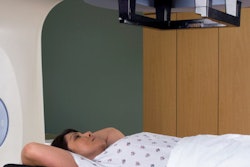
Contrast-enhanced spectral mammography (CESM) is a good alternative to MRI in evaluating invasive breast cancers, according to research published August 27 in Clinical Imaging.
A team led by Dr. Sandy Lee from the University of Southern California found that spectral mammography has comparable sensitivity to breast MRI, as well as better specificity. The researchers touted CESM as a promising tool for underrepresented patient populations.
"This prospective data shows that ... contrast-enhanced spectral mammography has similar sensitivities and fewer false positives than MRI in evaluating both index and additional lesions in the minority patients," Lee and colleagues wrote.
Disparities persist in diagnosis, treatment, and survival rate among racial, ethnic, and socioeconomic groups, with breast cancer being the number one cause of cancer death in Hispanic women in the U.S., the researchers said.
"In general, minority women, including Hispanics and African Americans, tend to be diagnosed with larger and more aggressive breast cancers when compared to non-Hispanic whites and are less likely to receive the recommended treatments," they added.
Contrast-enhanced breast MRI is the standard in local staging of breast cancer with better sensitivity than standard mammography or ultrasound, but its lower specificity leads to more false positives. Retention of gadolinium contrast in the brain is another concern with MRI, despite no known clinical effects.
For underrepresented populations and lower socioeconomic groups, the high cost and limited availability of MRI makes access harder.
On the other hand, contrast-enhanced spectral mammography can be performed with conventional mammography equipment and an iodinated contrast agent. CESM can help spot potentially malignant tissue by acquiring images at different x-ray energy levels and demonstrating differences in the response of different kinds of tissue.
In the new study, the team wanted to compare the clinical efficacy of contrast-enhanced spectral mammography and MRI as supplements to mammography and ultrasound to identify the extent of disease in women with newly diagnosed invasive breast cancer.
The group looked at data from 41 patients whose ages ranged from 35 to 82 years. Most of the women were from underrepresented populations, including 25 Hispanic, 10 non-Hispanic white, two African American, and four Asian participants.
| Spectral mammography vs. MRI in evaluating breast lesions | ||
| MRI | Contrast-enhanced spectral mammography | |
| Sensitivity | 94.7% | 92% |
| Specificity | 0% | 74.4% |
| Positive predictive value | 85.7% | 95.8% |
| False-positive rate | 100% | 28.6% |
The researchers said that spectral mammography has greater specificity and positive predictive value because MRI tends to overcall benign lesions. MRI, meanwhile, did not detect two index cancers, while CESM did not detect three index cancers.
In 24 patients who had spectral mammography, MRI, and surgical pathology for direct comparison, MRI overcalled six lesions as suspicious that were later found to be benign. Spectral mammography, meanwhile, overcalled one lesion.
Despite limitations such as contrast-enhanced spectral mammography having a higher degree of radiation than 2D mammography and potential reaction to iodinated contrast, the team plans to use the study's data to further evaluate the efficacy of contrast-enhanced spectral mammography in underrepresented minority patients.
"For patients with newly diagnosed invasive breast cancer, it is crucial to determine the extent of the index cancer and any additional ipsilateral or contralateral lesions to accurately guide treatment," the study authors wrote. "This study demonstrates the efficacy of contrast-enhanced spectral mammography compared to MRI in the setting of newly diagnosed cancers in a cohort of predominantly underrepresented minority patients."




















